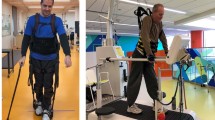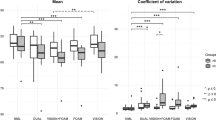Abstract
Study design:
Retrospective study of the degree of gait independence achieved by persons with spinal cord injury (SCI) using knee–ankle–foot orthosis with a medial single hip joint (MSH-KAFO).
Objective:
To examine the effects of the neurological level, degree of paresis, age, and inhibitory physical/other factors on the gait with a MSH-KAFO in patients with SCIs.
Setting:
Three university hospitals and two rehabilitation hospitals in Japan.
Methods:
The 45 patients (36 men, nine women) examined included 10 with injuries in the cervical cord between C6 and C8 (group C), 20 with injuries in the upper-middle thoracic cord between T4 and T10 (group UT), and 15 with injuries in the lower thoracic-lumbar cord between T12 and L1 (group TL). Mean age was 34.0 years (range 16–68 years). Of these patients, 13 used the Walkabout, four used the gear joint, and 28 used the Primewalk as the medial hip joint. Recursive partitioning, which predicted the final status of gait from the level, degree of paresis, age, and inhibitory factors, was performed, and a decision tree for gait was constructed. Inhibitory factors were spasticity, involuntary spasms or muscle contractions, pain, contracture, weakness of the upper extremities, and decreased motivation to perform gait exercise. The degree of gait independence was rated on the following five-point scale: outdoor independent gait (5 points), indoor independent gait (4 points), indoor supervised gait (3 points), indoor assisted gait (2 points), and gait within parallel bars (1 point). New branches were added to the decision tree for gait based on the clinical experience, thereby constructing a new decision tree.
Results:
The coincident ratio between the value predicted on the basis of the decision tree of gait and the value actually observed was 53.3%. The coincident ratio between the value predicted on the basis of the modified decision tree of gait and the actually observed value was 68.9%.
Conclusion:
The results provide valuable information to medical teams that may assist prescription of gait orthoses.
Similar content being viewed by others
Login or create a free account to read this content
Gain free access to this article, as well as selected content from this journal and more on nature.com
or
References
Kunkel CF, Scremin AME, Eisenberg B, Garcia JF, Roberts S, Martinez S . Effect of standing on spasticity, contracture, and osteoporosis in paralyzed males. Arch Phys Med Rehab 1993; 74: 73–78.
Kaplan P, Gandhabadi B, Goldschmidt J . Calcium balance in paraplegic patients: influence of injury duration and ambulation. Arch Phys Med Rehab 1978; 59: 447–450.
Messenger N, Rithalia SVS, Bowker P, Ogilvie C . Effects of ambulation on the blood flow in paralysed limbs. J Biomed Eng 1989; 27: 70–75.
Cybulski GR, Jeager RJ . Standing performance of persons with paraplegia. Arch Phys Med Rehab 1986; 67: 103–108.
Stallard J, Major RE, Patrick JH . A review of the fundamental design problems of providing ambulation for paraplegic patients. Paraplegia 1989; 27: 70–75.
Douglas R, Larson P, D Ambrosia R, McCall RE . The LSU reciprocation gait orthosis. Orthopedics 1983; 6: 834–839.
Lotta S et al. Restoration of gait with orthoses in thoracic paraplegia: a multicentric investigation. Paraplegia 1994; 32: 608–615.
Franceschini M, Baratta S, Zampolini M, Loria D, Lotta S . Reciprocating gait orthoses: a multicenter study of their use by spinal cord injured patients. Arch Phys Med Rehab 1997; 78: 582–586.
Thoumie P et al. Restoration of functional gait in paraplegic patients with the RGO-II hybrid orthosis. A multicenter controlled study. I: clinical evaluation. Paraplegia 1995; 33: 647–653.
Rose GK . The principles and practice of hip guidance articulations. Prosthet Orthot Int 1979; 3: 37–43.
Ferrain M, Pedotti A, Boccardi S, Palmieri R . Biomechanical assessment of paraplegic locomotion with hip guidance orthosis. Clin Rehab 1993; 7: 303–308.
Saitoh E et al. Clinical experience with a new hip–knee–foot orthotic system using a medial single hip joint for paraplegic standing and walking. Am J Phys Med Rehab 1996; 75: 198–203.
Middleton JW, Yeo JD, Blanch L, Vare V, Peterson K, Brigden K . Clinical evaluation of a new orthosis, the ‘Walkabout’, for restoration of functional standing and short distance mobility in spinal paralysed individuals. Spinal Cord 1997; 35: 574–579.
Saitoh E, Baba M, Sonoda S, Tomita Y, Suzuki M, Hayashi M . A new medial single hip joint for paraplegic walkers. In: Ueda S, Nakamura R, Ishigami S (eds). The Eighth World Congress of International Rehabilitation Medicine Association. Monduzzi Editore: Bologna, Italy 1997, pp 1299–1305.
Sonoda S, Imahori R, Saitoh E, Tomita Y, Domen K, Chino N . Clinical application of the modified medially-mounted motor-driven hip gear joint for paraplegics. Disabil Rehab 2000; 22: 294–297.
Long C, Lawton EB . Functional significance of spinal cord lesion level. Arch Phys Med 1955; 36: 249–255.
Solomonow M et al. Reciprocating gait orthosis powered with electrical muscle stimulation (RGO II). Part 1, performance evaluation of 70 paraplegic patients. Orthopedics 1997; 20: 315–324.
Waters RL, Lunsford BR . Energy cost of paraplegic locomotion. J Bone Joint Surg Am 1985; 67: 1245–1250.
Hussey RW, Stauffer ES . Spinal cord injury: requirements for ambulation. Arch Phys Med Rehab 1973; 54: 544–547.
Zankel HT, Sutton BB, Burney TT . A paraplegic program under physical medicine and rehabilitation: one year's experience. Arch Phys Med 1954; 35: 296–302.
Munro D . Rehabilitation of patients totally paralysed below waist, with special reference to making them ambulatory and capable of earning their own living. N Engl J Med 1954; 250: 4–14.
Gordon EE, Vanderwalde H . Energy requirements in paraplegic ambulation. Arch Phys Med 1956; 36: 276–285.
Liu M, Tsuji T, Tsujiuchi K, Chino N . Comorbidities in stroke patients as assessed with a newly developed comorbidity scale. Am J Phys Med Rehab 1999; 78: 416–424.
Falconer JA, Naughton BJ, Dunlop DD, Roth EJ, Strasser DC, Sinacore JM . Predicting stroke inpatient rehabilitation outcome using a classification tree approach. Arch Phys Med Rehab 1994; 75: 619–625.
Bernardi M, Canale I, Castellano V, Di Filippo L, Felci F, Marchetti M . The efficiency of walking of paraplegic patients using a reciprocating gait orthosis. Paraplegia 1995; 33: 409–415.
Skyes L, Campbell IG, Powell ES, Ross ERS, Edwards J . Energy expenditure of walking for adult patients with spinal cord lesions using the reciprocating gait orthosis and functional electrical stimulation. Spinal Cord 1996; 34: 659–665.
Harvey LA, Davis GM, Smith MB, Engel S . Energy expenditure during gait using the Walkabout and isocentric reciprocating gait orthosis in person with paraplegia. Arch Phys Med Rehab 1998; 79: 945–949.
Scivoletto G, Morganti B, Ditunno P, Ditunno JF, Molinari M . Effects of age on spinal cord lesion patients' rehabilitation. Spinal Cord 2003; 41: 457–464.
Author information
Authors and Affiliations
Rights and permissions
About this article
Cite this article
Suzuki, T., Sonoda, S., Saitoh, E. et al. Prediction of gait outcome with the knee–ankle–foot orthosis with medial hip joint in patients with spinal cord injuries: a study using recursive partitioning analysis. Spinal Cord 45, 57–63 (2007). https://doi.org/10.1038/sj.sc.3101955
Published:
Issue Date:
DOI: https://doi.org/10.1038/sj.sc.3101955



